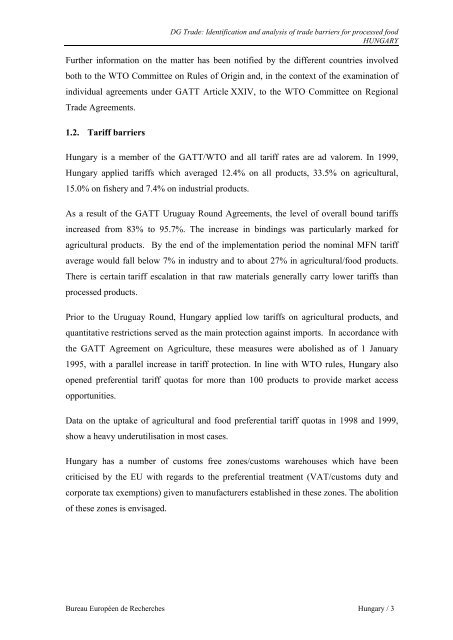HUNGARY Report.pdf - Agra CEAS Consulting
HUNGARY Report.pdf - Agra CEAS Consulting
HUNGARY Report.pdf - Agra CEAS Consulting
- No tags were found...
Create successful ePaper yourself
Turn your PDF publications into a flip-book with our unique Google optimized e-Paper software.
DG Trade: Identification and analysis of trade barriers for processed food<strong>HUNGARY</strong>Further information on the matter has been notified by the different countries involvedboth to the WTO Committee on Rules of Origin and, in the context of the examination ofindividual agreements under GATT Article XXIV, to the WTO Committee on RegionalTrade Agreements.1.2. Tariff barriersHungary is a member of the GATT/WTO and all tariff rates are ad valorem. In 1999,Hungary applied tariffs which averaged 12.4% on all products, 33.5% on agricultural,15.0% on fishery and 7.4% on industrial products.As a result of the GATT Uruguay Round Agreements, the level of overall bound tariffsincreased from 83% to 95.7%. The increase in bindings was particularly marked foragricultural products. By the end of the implementation period the nominal MFN tariffaverage would fall below 7% in industry and to about 27% in agricultural/food products.There is certain tariff escalation in that raw materials generally carry lower tariffs thanprocessed products.Prior to the Uruguay Round, Hungary applied low tariffs on agricultural products, andquantitative restrictions served as the main protection against imports. In accordance withthe GATT Agreement on Agriculture, these measures were abolished as of 1 January1995, with a parallel increase in tariff protection. In line with WTO rules, Hungary alsoopened preferential tariff quotas for more than 100 products to provide market accessopportunities.Data on the uptake of agricultural and food preferential tariff quotas in 1998 and 1999,show a heavy underutilisation in most cases.Hungary has a number of customs free zones/customs warehouses which have beencriticised by the EU with regards to the preferential treatment (VAT/customs duty andcorporate tax exemptions) given to manufacturers established in these zones. The abolitionof these zones is envisaged.Bureau Européen de Recherches Hungary / 3













